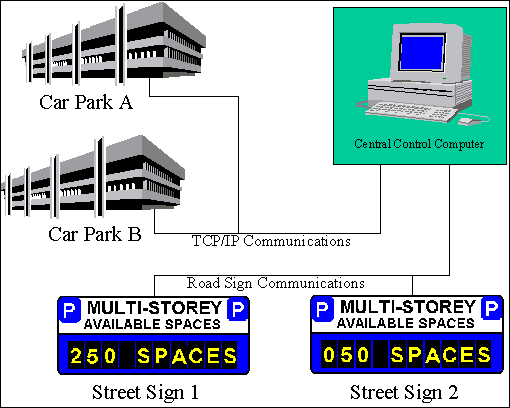
|
Car Park Guidance & Variable Message Signs System |
e-Park
- THE SMART CAR PARK GUIDANCE
SYSTEM
The e-Park system
is a total solution that provides comprehensive information on the availability
of parking spaces, to guide motorists in advance, as they approach the vicinity
of the town or city centre as well as upon entering the car parks. The system can be customised to meet the specific
requirements of various types of parking facilities.
The main components of the Parking Guidance Information (PGI) system are Vehicle Detection Processors (VDPs) and Variable Message Signs (VMS). In addition, each car park will be equipped with a central processor which controls each PGI system.
VDPs are installed at vehicle entry and exit points within a defined area or zone to perform the vehicle counting function. These patented innovative VDPs have been designed to provide a highly accurate vehicle monitoring solution, allowing the operator to reliably display space availability and guidance information to users of their car parks. As a result of the high degree of accuracy, customers of the car parks will place confidence in the information provided and, consequently, will heavily influence their parking behaviour. Customers who have satisfactory experiences of car parks that provide reliable guidance information will be more likely to use these facilities on a regular basis. It will enhance their overall usage experience of not only the car parking facilities, but also their experience of the adjacent facilities (e.g. shopping centre, restaurants, hotels, etc.).
The e-Park system is designed to provide effective PGI solutions to individual car
parks as well as offering the possibility of linking a large number of car parks
together, as illustrated in Figures
1 & 2.

Figure 1 : Overview of e-Park System

Figure 2: Architecture of e-Park solution linking a group of Car Parks
Variable Message Signs
(VMS)
PGI data is transmitted to VMS located throughout the
car park. Further external VMS are
generally required to provide PGI to drivers approaching the parking facility.
Figure 3 shows examples of the types of VMS that can be used in the solution:

Figure 3: Typical Variable Message Signs (VMS)
Communications
Communication from the system to the displays can be
performed in two ways. Firstly, and
where appropriate, communication can be performed by means of hardwire link.
Secondly, where required (e.g. for communication to a remote VMS),
communication can be by means of radio link.
A transmitter will generally be placed on the roof of the multi-storey
car park and will be connected to the central computer.
Receivers will also be required for each of the displays.
In this way, guidance messages can be refreshed on a regular basis (e.g.
every 30 seconds).
The software is available in two broad formats - a
basic version of the control software, and an advanced version.
The basic version of the software would allow the operator to perform the
following functions:
Reset: A manual reset function will be made available to the users, allowing them to override the system when necessary.
Control
of VMS: User-defined thresholds are established to determine appropriate
messages to be displayed on the signs. For example, a ‘FULL’ message can
be displayed when the level of space availability reaches a preset threshold
value of, say, 5. A manual
overwrite of the displayed information is also available for displaying
messages, when required (e.g. display ‘CLOSED’ when car park is
temporarily closed for cleaning etc.).
Health
Monitoring of VDP: The system
can be routinely monitored to check the operation of the VDPs which
automatically report their status to the central computer.
If a problem arises, this alerts the user to the location of the VDP
and the nature of the problem.
Data
regarding average occupancy and number of movements will be automatically
stored in databases on the computer. This allows the operator to download
the information from the central computer and take it away for analysis at a
remote site, using standard database packages.
The advanced version of the software, in addition to the above-described functions, provides a number of extra features. The advanced software version is available in a Windows-based package and provides the operator with real-time space availability information. This package incorporates a user-friendly graphical user interface (GUI) which allows the operator to access a host of functions directly from the control PC. Comprehensive car park management statistics are available with this package and occupancy and vehicle movement data is provided in a range of graphical and tabular formats. In addition, this package offers two separate types of alarm: a static alarm which alerts the operator to near-capacity situations within the car park; and a dynamic alarm which is based on the actual rate of traffic flow within the car park. Furthermore, control of the VMS from the control PC is facilitated by the advanced software as it allows the operator to remotely access and control the VMS and the actual information currently being displayed.
|
Features |
Benefits |
|
·
Highly Accurate ·
Low Maintenance ·
Easily Installed ·
Zone-Specific ·
Detailed Management Software ·
Networked/Modular Solution ·
Customisable to ALL types of facilities |
·
Increased Space Utilisation ·
Increased Revenue ·
Detailed Management Information ·
Reduced Manpower Requirements ·
Improved Traffic Flow ·
Reduced Fuel Emissions ·
Customer Satisfaction |
Return To : Bco's Homepage Business